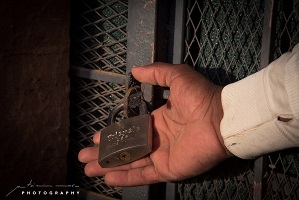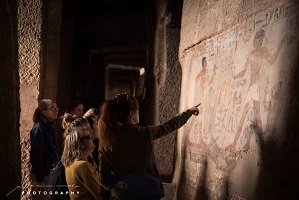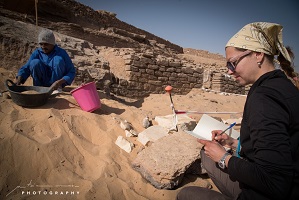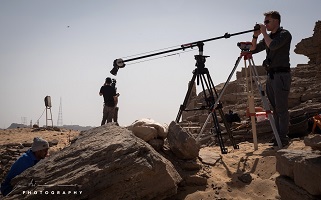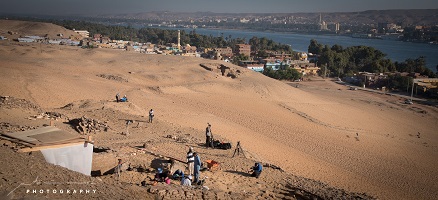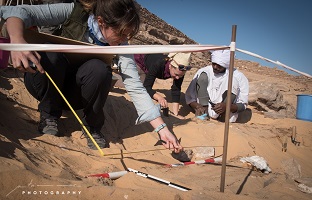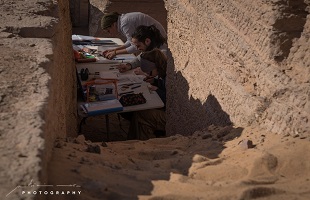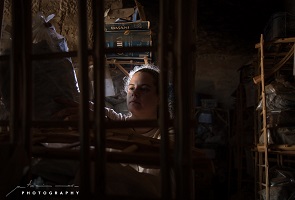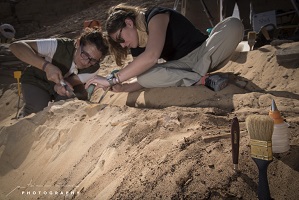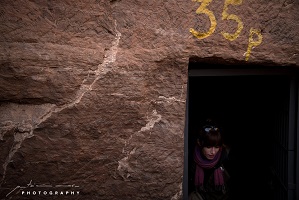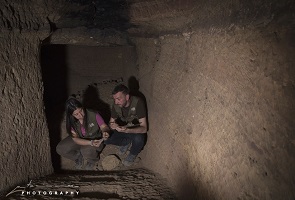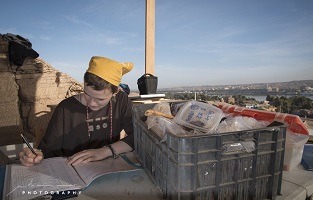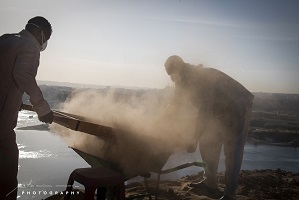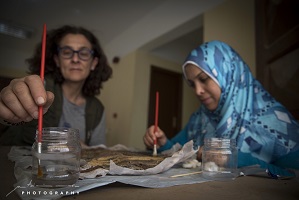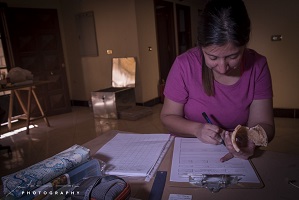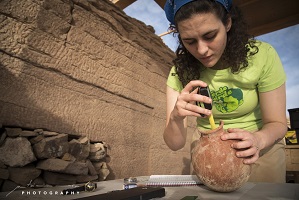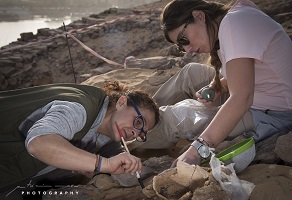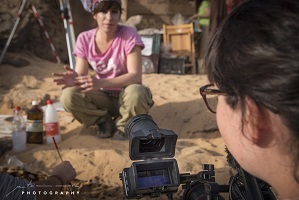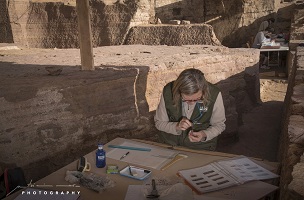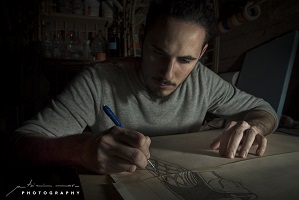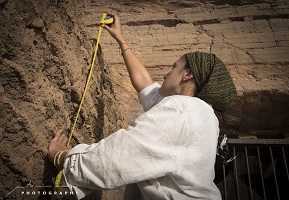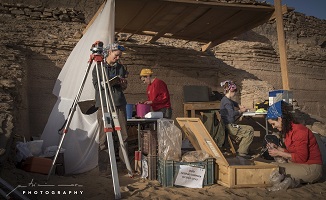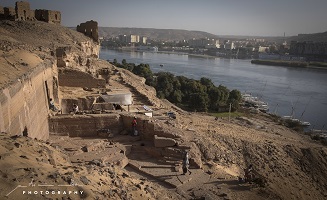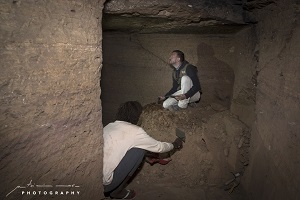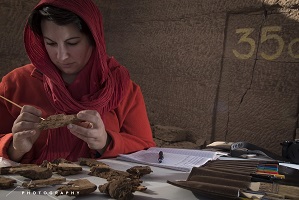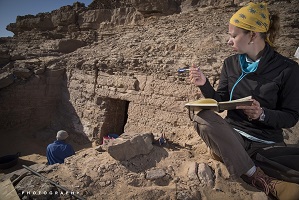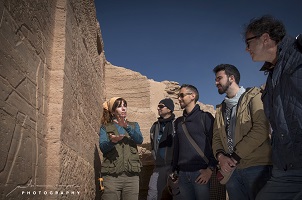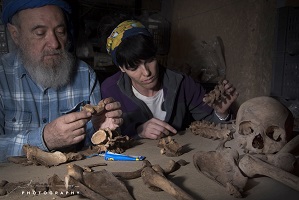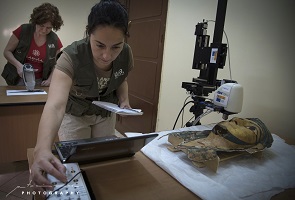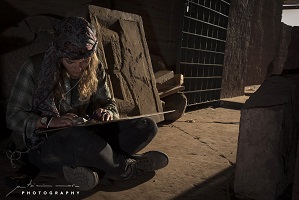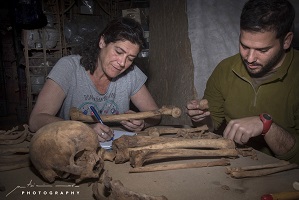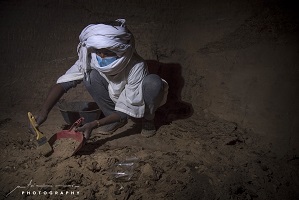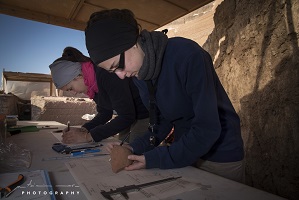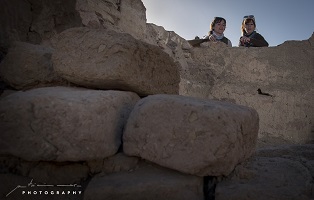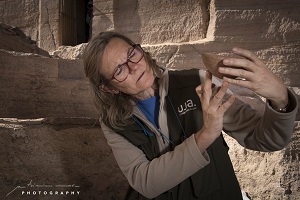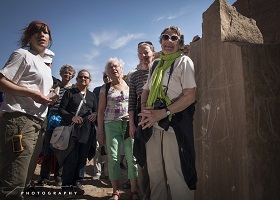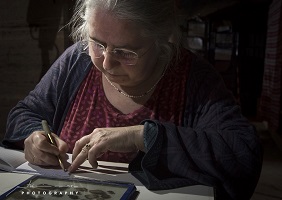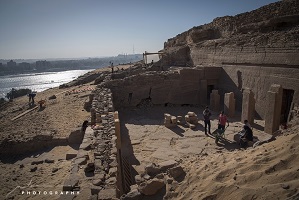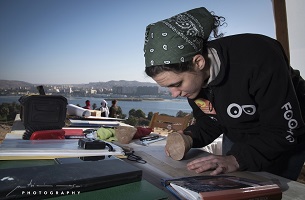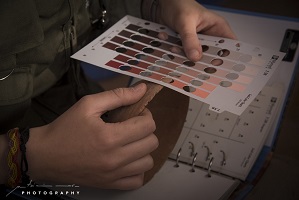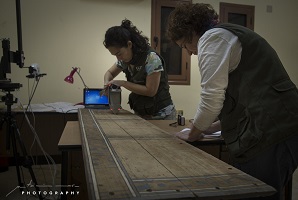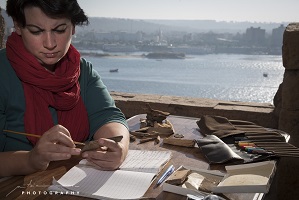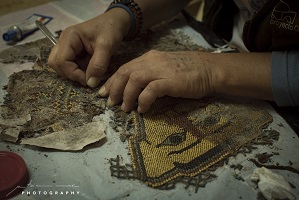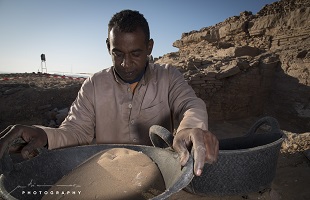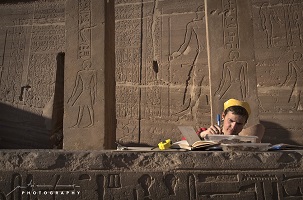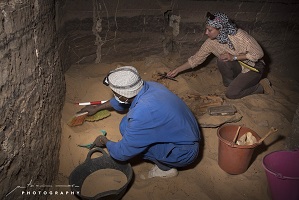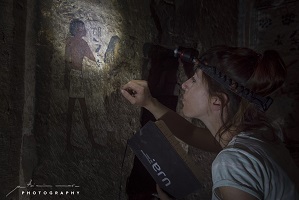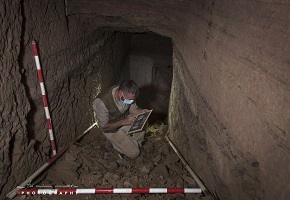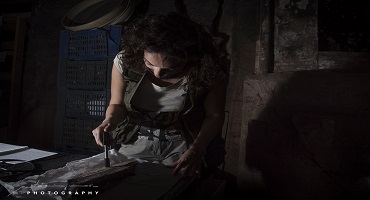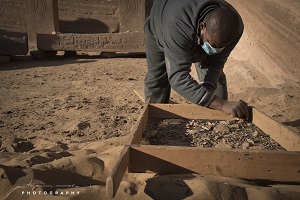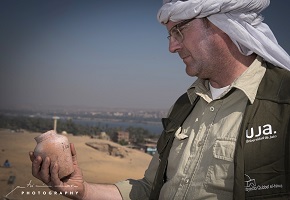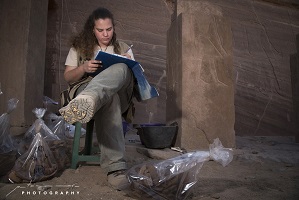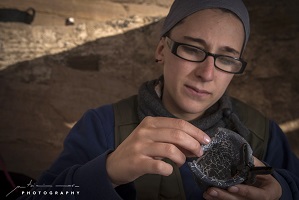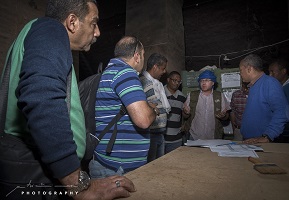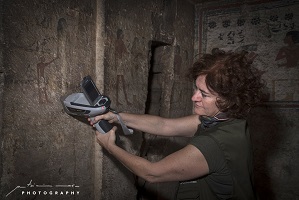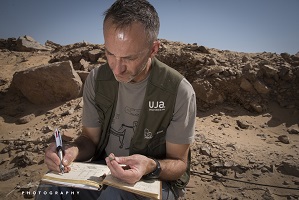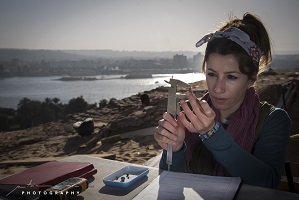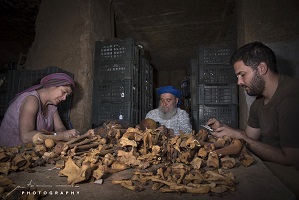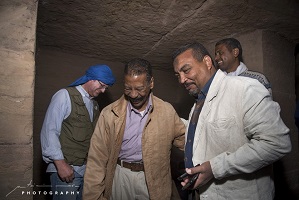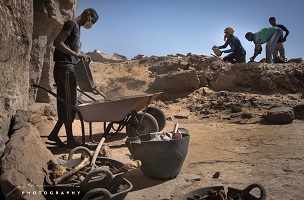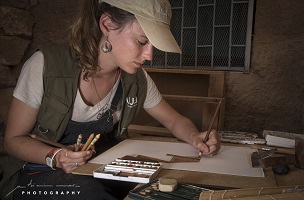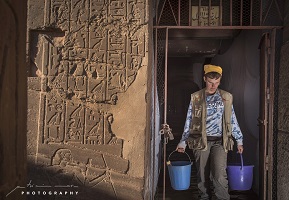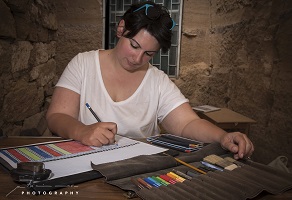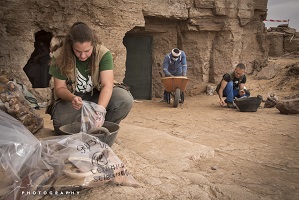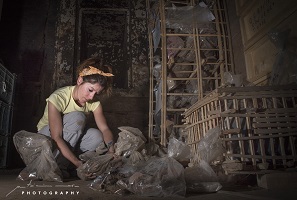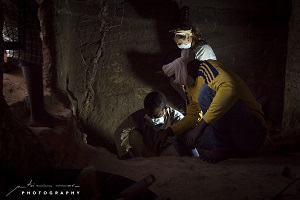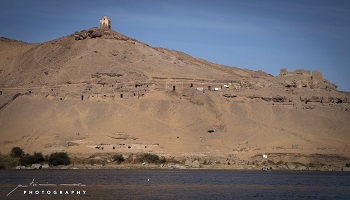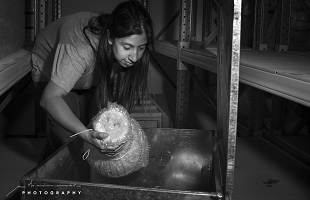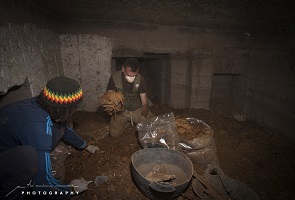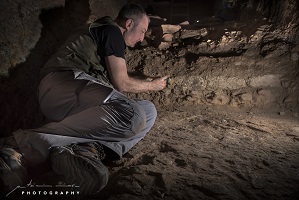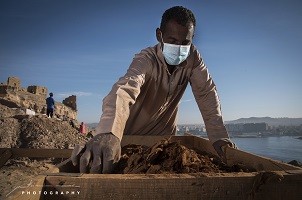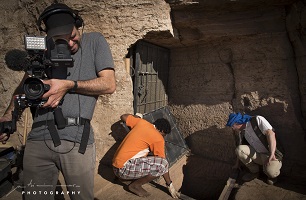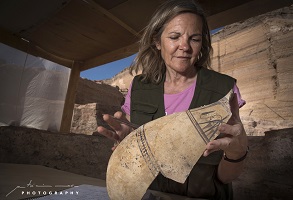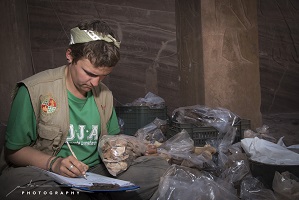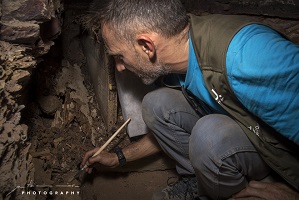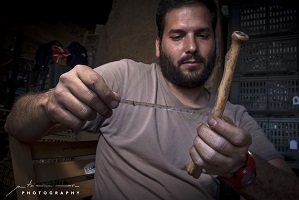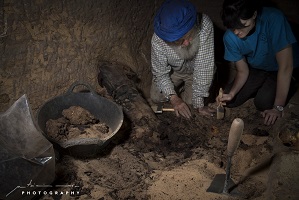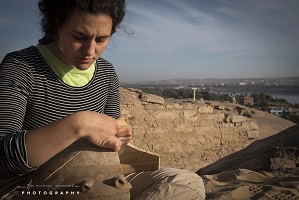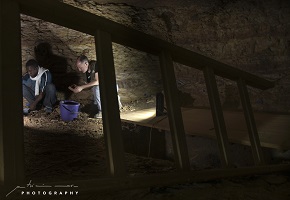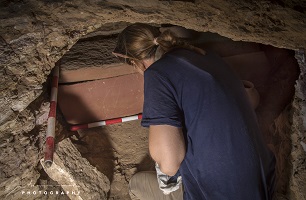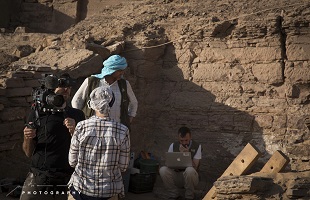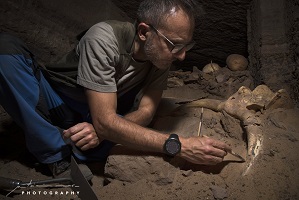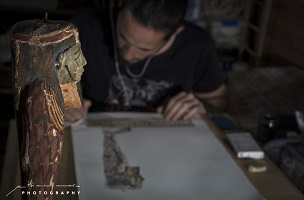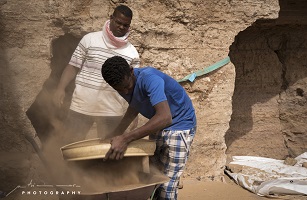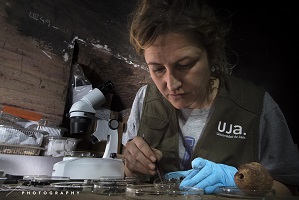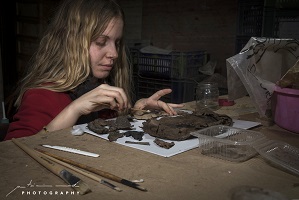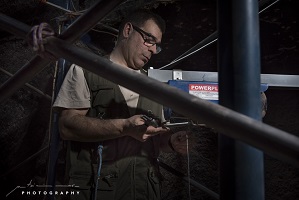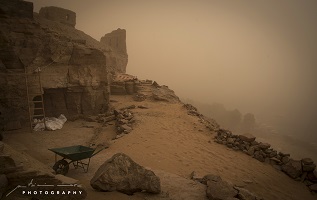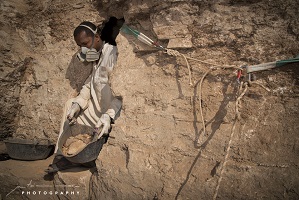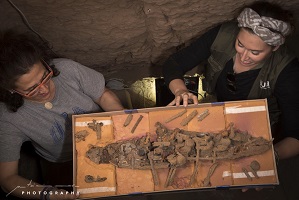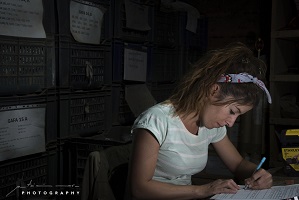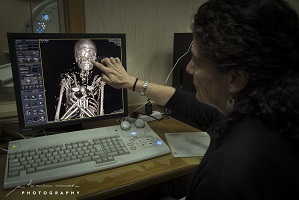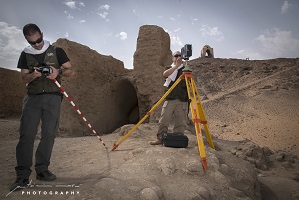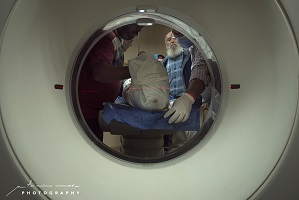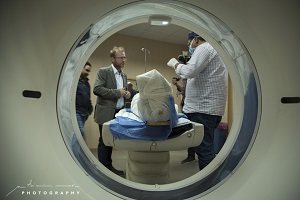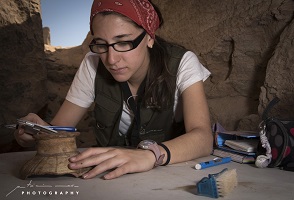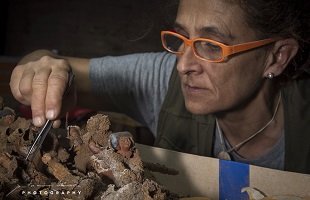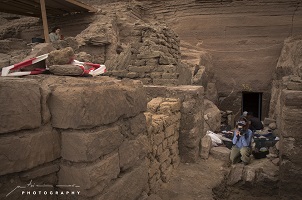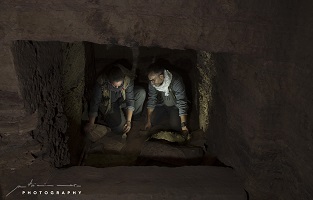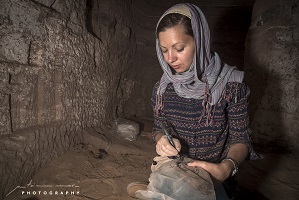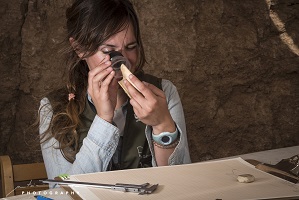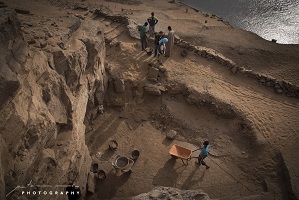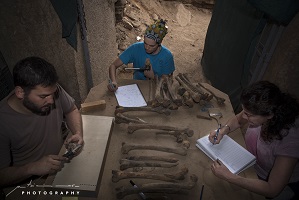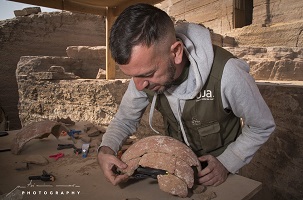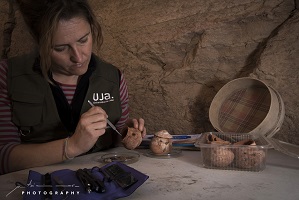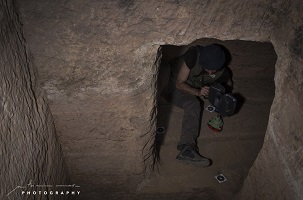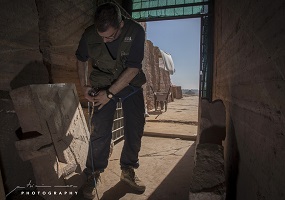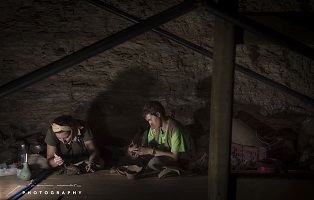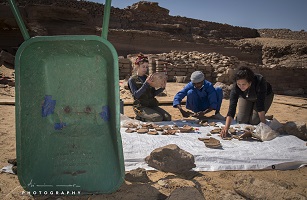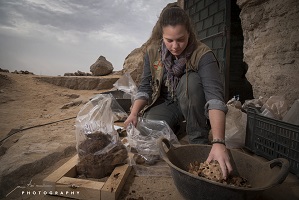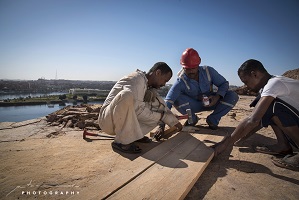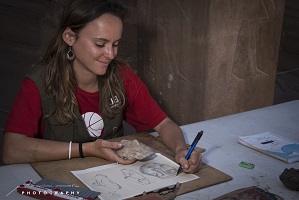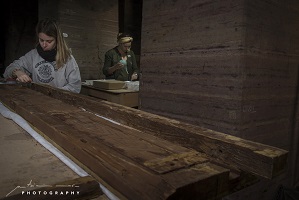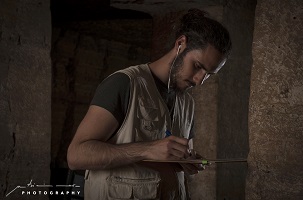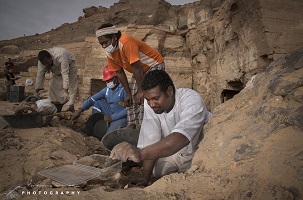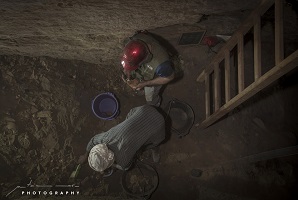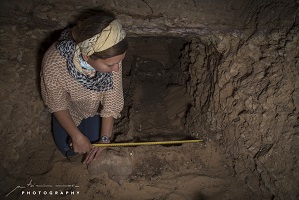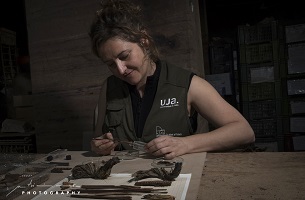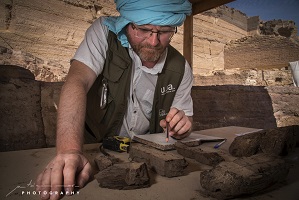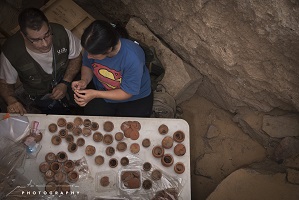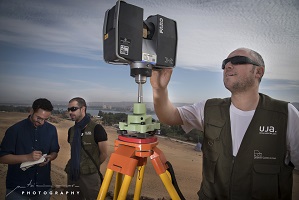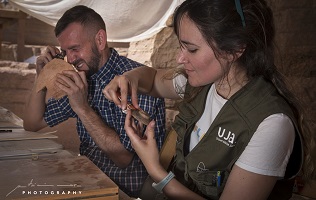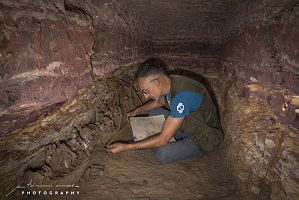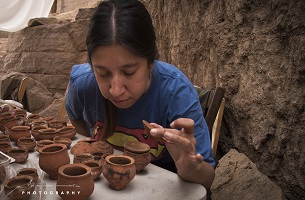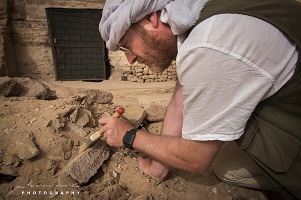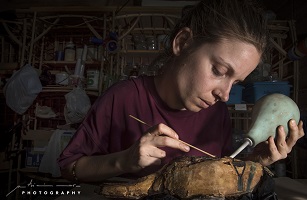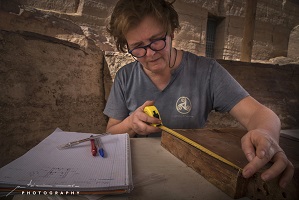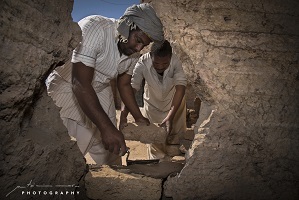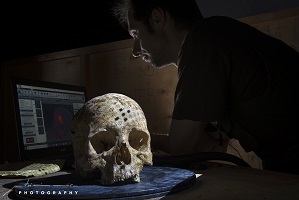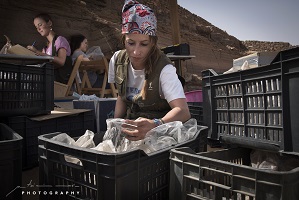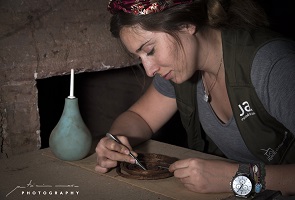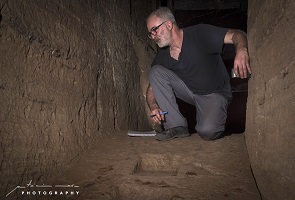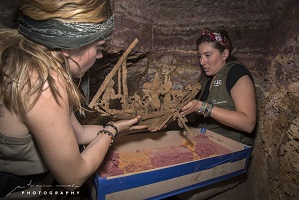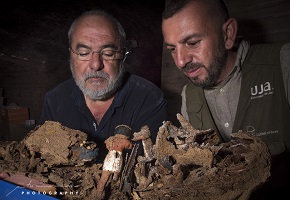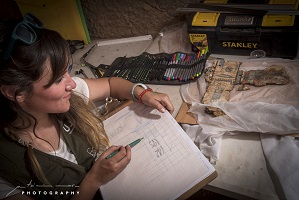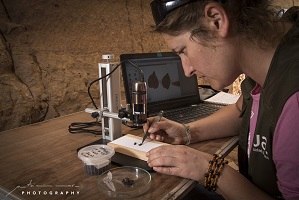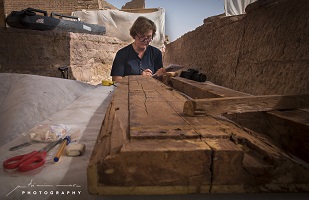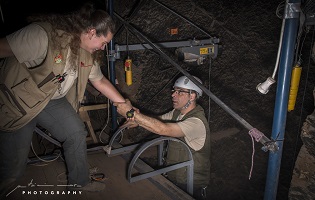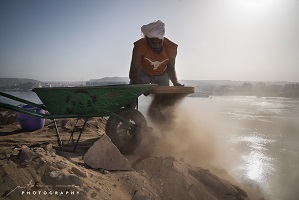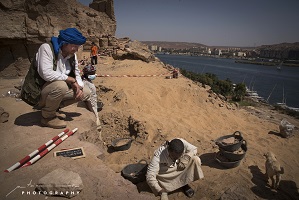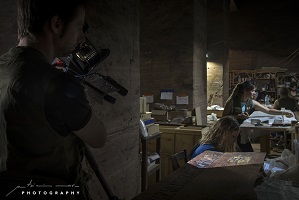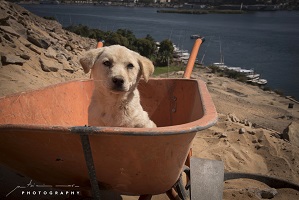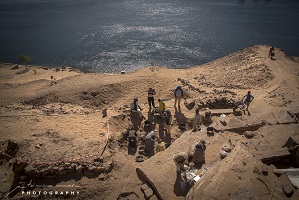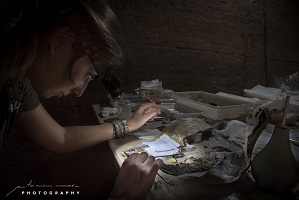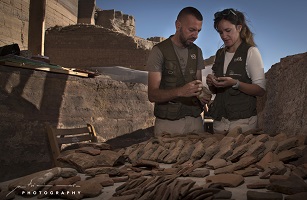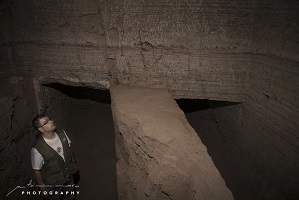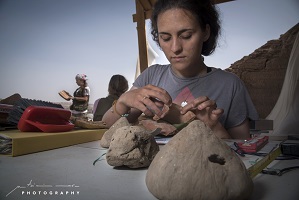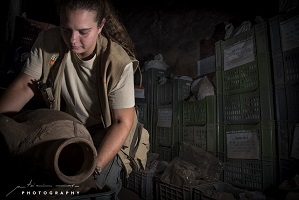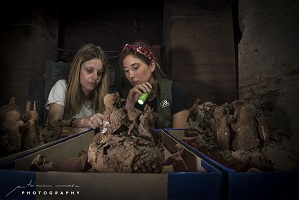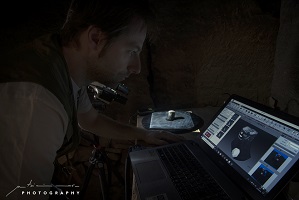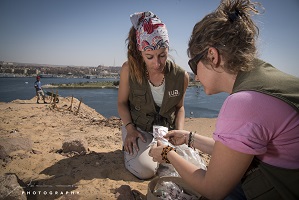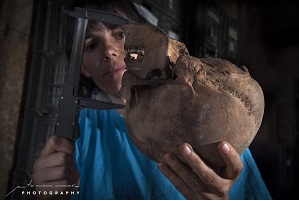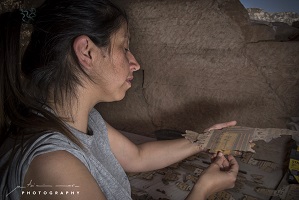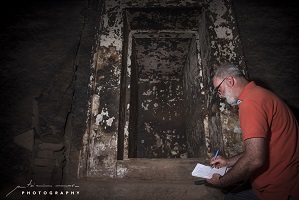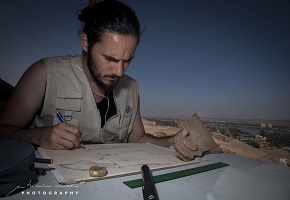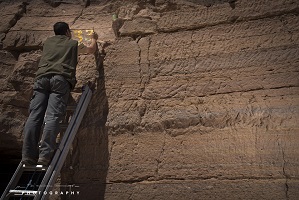Day 1
Today was the first day of work at the Qubbet el-Hawa necropolis. The team was formed by sixteen members, some of which were veteran, while others were joining in for the first time. We proceeded to the opening of the QH33 tomb, the largest on site, under the supervision of the local authorities.
This year, the director, Alejandro Jiménez Serrano, was unable to attend, so the co-director, José Manuel Alba, led the opening tasks. To start with, Luisa gave us a very comprehensive tour of the necropolis which greatly helped the new team members obtain a better understanding of the context of the excavation.
Afterwards, filled with excitement, each team moved to their tomb with the aim of coinditioning their working area. We were also joined by a TV crew who wished to document the activities of the excavation team from the offset.
Teresa and Sara prepared various last season pieces from a number of tombs in order to start working on their conservation tomorrow. The pottery team, led by María José, started drawing, photographing and documenting some pieces excavated last season. Martina and Ana excavated a level from QH33o in order to access QH33n; during these works a burial emerged, including part of a skull and the edges of a coffin.
Work is expected to continue in this area tomorrow, where no doubt further interesting burials will surface.
Day 2
Today was an exciting day at the necropolis; just as we anticipated yesterday, another burial has appeared within the courtyard of QH35o, this time with remains of a cartonnage.
Teresa and Sara, the conservators, proceeded to consolidate the face area in the field. They also started gluing together fragments of decoration from a cartonnage excavated last year. In addition, Ana Belén undertook the archaeological drawing of yesterday's burial, which turned out to be that of a child, in order to contextualise it in relation to the tomb and its surroundings.
The pottery team continued drawing and documenting pottery, while Cristina revised material from last season and prepared boxes for the carpology and anthropology teams. Lastly, Luisa, José Manuel and Yolanda visited Dr Mohamed Abd el-Manem, general director of the Aswan and Nubia Antiquities areas.
Day 3
After the first few days of setting up and organising the work for this season, work at the necropolis has now taken on an excellent rhythm and all the teams are immersed in their tasks. Jose Manuel and Yolanda started work in QH32. Yolanda also visited the warehouse, together with Teresa and Patricia. The three of them are preparing for a very exciting event for the whole Qubbet el-Hawa team, the future exhibition at the Museum of Aswan.
Teresa started restoring some pieces ready for the exhibition whilst Patricia setup her photographic studio and began photographing some of the finds from previous seasons, and Yolanda continued organising and preparing pieces for this exciting event.
In addition, Ana revised drawings from previous campaigns belonging to QH35p; this year's main objective. Ana and Martina continued excavating QH35n, whilst Sara continued to consolidate the cartonnage found yesterday. The pottery team had a beautiful surprise when they found a lotus flower motif on a sherd, which Sara then cleaned and consolidated.
Day 4
Today had a mixture of interesting finds and important work at Qubbet el-Hawa. The pottery team continued drawing and documenting pottery from QH33 with María José leading the tasks, while Luisa and Ana revised and drew material from QH35p. Martina and Ana continued excavating QH35n and found collapsed stone and brick.
They also encountered a fantastic find: a cornaline bead in the shape of a fly. Yolanda was in the warehouse, coordinating the preparation tasks for the exhibition, accompanied by Patricia and Teresa. In tomb QH32, Jose excavated cartonnage masks and a little basket, beautifully preserved, which Sara has consolidated and moved to the conservation area.
Finally, Dr Mohamed Abd el-Manem, general director of Nubia and Aswan Antiquities, returned our previous visit, together with Dr Basem Gehad, assistant to the Minister of Capacity Development. Today's activities were documented by the TV crew, who joined us again to follow our work.
Day 5
Today it was the last day of this working week because tomorrow it is the celebration of the Egyptian Revolution Day, so the team has one extra day off in this first week. Most of them have gone to Luxor, city that offers a lot of monuments and archaeological sites to visit.
The work in the necropolis has been developed at full capacity. In the northern area, material found in the tomb QH35p during the last three seasons is still being studied by Luisa and María, and Martina is also working on the excavation of the courtyard of the hypogeum QH35n, which is carrying on in a very good rhythm.
If nothing happens, we will be able to see the complete door very soon. Moreover, the burial found in front of the tomb QH35o has been finally removed but, unfortunately and despite the efforts, the cartonnage that covered the deceased has been broken noticeably.
In the southern area, José is still carrying the works in the tomb QH32, particularly in the antechamber of the funerary shaft, whose stratigraphy is virtually finished. Javi, for his part, has been drawing a Ptah-Sokar- Osiris and María Correas has registered the different types of mud-bricks used around the necropolis to distinguish possible typologies.
Day 6
Today has seen the arrival of new team members, which no doubt will be a great addition to the day to day on site. Firstly, Miguel and Inma, the anthropologists who joined us in previous campaigns, arrived together with Chari, a new team member. Together, they started studying a skeleton from last season which presented multiple pathologies.
It was also the first day for the chemical analysis team, María José and Ana, who worked in the lab analysing metal objects previously selected by Yolanda, as well as pigments from cartonnage masks.
Martina continued excavating QH35n, where she found an incense bowl with remains of charcoal, as well as fayence beads of various sizes. In addition, the pottery team continued documenting pottery from both tombs QH33 and QH35p at a good pace, whilst in the latter Ana Belén drew a mud brick wall which would have blocked the entrance to one of the funerary chambers in the courtyard.
Jose found mixed remains belonging to the Middle and New Kingdom periods in QH32, such as mud bricks, incense bowls, decomposed bandages, a small cartonnage mask, etc., as well as remains of charcoal. Sara, the conservator, continued cleaning and consolidating the small basket found in QH32, as well as various cartonnages. Lastly, we were lucky enough to have members of the Proyecto 209 team visit us from Luxor, who received a complete tour of the necropolis from Luisa.
Day 7
Work at the Qubbet el-Hawa hill continues at a very good pace, and so does that of the warehouse. There, Yolanda revised the boxes to produce a list of the materials that are to remain there and Teresa consolidated and cleaned other pieces for the catalogue, which were also photographed. Also in the warehouse, Ana and María José continued to undertake chemical analysis of metallic pieces, some amulets and stone beads, as well as the cartonnage pigments of Sarenput and Heqaib.
Gersande for her part has been working with the wooden models from QH33 to identify the types of wood used, and comparing them to those of previous excavations. Also, she investigated the manufacturing techniques of both Sarenput's coffin and that of a shabti found with it. Meanwhile, the anthropology team has continued to review the materials found in tomb 34aa, investigating their biological characteristics, metrics and analysing the pathological features of each individual.
Also, Miguel and Chari have been helping Jose excavate material from QH32, where the clearing of the antechamber of the well has finished. There the remains of a mud pile with straw on top has been found, as well as remains of boxes with red and white pigment. They also accessed the ramp leading to the funerary chamber.
The members of the drawing team undertook a variety of activities. As well as continuing to document the pottery, Maria Naranjo drew a large offering table which was found during the 2010 campaign, as well as beads and a fragment of a polychrome coffin. Ana Belén has been drawing the polychromy from the cartonnage remains found in tomb QH32. Finally Sara, finished the consolidation and reconstruction of the small basket and cleaned the funeral masks found in QH32, as well as the remains of the polychromy from cartonnages and some beads.
Day 8
Today was a day of important arrivals at the necropolis. Firstly, we received the visit of renowned Egyptologist Lise Manniche, accompanied by a group from Copenhagen; Jose and Luisa gave them a full tour of our area of work at Qubbet el-Hawa. Secondly, Miriam Krutzsch, conservator at the Egyptian Museum in Berlin, joined the team. Her main task will be to restore the papyrus found last season in QH122.
The warehouse also witnessed a great amount of activity; Gigi revised the coffins of Sarenput the Young and Sarenput II to try to establish their workshop of origin, whilst the chemical analysis team worked on their pigments and materials. They also did so for the coffins of Satjeni and Khema, for which task X-Ray fluorescence techniques turned out to be very useful.
The anthropologists and pottery team continued their tasks from yesterday, while Ana Belén drew the QH32 niche and its sections. Last but not least, Jose revised the pottery from well 9 at QH36, an ensemble which appears to be dated to the Middle Kingdom. In addition, Martina finished clearing the courtyard at tomb QH35n, whose chamber she hopes to access tomorrow.
Day 9
Today, Jose revised pottery from tomb QH34aa, as well as cleaning the antechamber of tomb QH32. Meanwhile, in QH35p, Luisa started excavating a test pit from last year which includes several pavements and abundant pottery.
Also, the anthropologists revised the bone material from QH35o and descended to the QH32 well to access a chamber excavated last year which contained a large accumulation of pottery. They were joined by María Correas, who is studying the mud bricks excavated inside tombs QH32, QH33 y QH35p, as well as the mud brick walls from the courtyards of tombs QH34, QH30 y QH35p. The chemical analysis team finished analysing the Middle Kingdom coffins and started studying those from the Late Period, with special attention to the presence of orpiment (arsenic trisulfide).
As far as the drawing team is concerned, María Naranjo drew a mirror handle and cosmetic box previously analysed by Gigi; the latter appears to be of good quality and perhaps imported.
Work continued also in the warehouse assisted by Essam, as well as Afaf, restoration inspector, whose actively participating in the conservation tasks, and Ahmed, warehouse inspector. There, boxes of bone material already studied will soon arrive. The whole team impatiently awaits the arrival tomorrow of the project director, Alejandro Jiménez Serrano.
Day 10
This week continues to be full of work. Jose kept on excavating the shaft in QH32, where he found a beautiful small face from the New Kingdom period, and Luisa studied the main tomb niche. Also, Gigi continued studying the wood from the coffins, which are covered with a varnish that does not allow for a conclusive dating so far.
Elsewhere, Martina, who works in QH35n, found a hieratic tablet whose translation is ongoing, as well as a colourful cartonnage. In QH36, Ana María also came across a beautiful finding, a polychrome shabti.
Meanwhile, in the lab, the chemical analysis team measured all coffins, and finally moved to the hill to continue their work the following days. Teresa undertook conservation of a funerary mesh, ready for the future exhibition. Last but not least, the pottery team continued working on documenting the material from QH33 and QH35p, whilst Ana Belén drew an elevation of QH34beta.
Day 11
Time flies and today was the last day of the second week of work at Qubbet el-Hawa. Martina found fragments of the other side of the hieratic tablet found yesterday in QH35n, which Teresa is due to restore. That was not the only finding, as Ana María came across a small terracotta face in QH36. In this tomb, some areas which were thought to have been previously excavated, started being uncovered and will probably offer some surprises.
In addition, Gigi continued studying both the wood from tomb QH32 which was uncovered last week, and some from last season belonging to QH33. Also in this tomb worked the anthropologists, who undertook identification, metrics and pathological study of some individuals. Some of them were also in tomb QH35n, helping excavate the remains of a mummy.
In QH32, Luisa finished taking the necessary notes for the study of the niche, and continued studying the material from QH35p, whilst the chemical team also understood their analysis. Meanwhile, Jose found large stone slabs who filled the shaft and was placed over Middle Kingdom pottery. However, the shaft was reached and it was not possible to continue without mechanical help. Cristina moved to QH36, where she started helping Ana classify and put material into bags.
The day finished in a beautiful way, since the whole team was invited to the wedding of Mahmoud, one of the Qubbet el-Hawa workers; we take this opportunity to thank him for his kindness. Tomorrow is our day off and, as usual, the team will visit another archaeological site, this time Elephantine, where Cornelius Von Pilgrim, director of the excavation, will give us a tour.
VIDEO SUMMARY OF THE FIRST WEEK
Day 13
Today we were visited by the Ministry of Antiquities Commission, who, led by Alejandro, inspected the archaeological pieces found and stored by the project throughout previous campaigns.
The tomb where Vicente is excavating (34bb) started offering very promising results. Amongst the most important pieces we must highlight a table of offerings which was found in situ, as well as abundant Coptic material, such as a beautiful ostracon fragment, and a papyrus which was taken to the restoration lab. In addition, varied relevant material was found which will be analysed in the next few days.
In the North area of the necropolis, excavation work continued in the main shaft of QH36. If everything goes well, the antechamber will be reached by the end of this week. The large amount of material meant sometimes Ana María needed the help of Cristina to register and classify the material. Meanwhile, María Naranjo drew the most important pieces. In addition, Luisa continued studying the QH35p material from previous campaigns.
Day 14
Work continues on site. This morning began with a second visit by the members of the Ministry of Antiquities, who had already visited us yesterday. This time, they were accompanied by Dr Abdelmanen Said, General Director of Nubia and Aswan Antiquities. Not only that, but also Dr Marleen De Meyer, came to see the site, leading a group of MA Egyptology students from the University of Leuven, Belgium.
With regards progress throughout the site, Vicente, who is excavating QH34bb, is continuously bringing material to light such as abundant bones, which the anthropology team is already studying. Work around this tomb today was particularly hard, as we have started to experience really high temperatures.
QH35b, where Martina is excavating, is also giving the team many surprises. Recently, a mummy surfaced which Miguel and Chari, from the Anthropology team, are currently studying. That mummy was found with important remains of cartonnage necklace beads, which are currently waiting for restoration and documentation.
In addition, María Naranjo is currently drawing the wooden remains studied by Gigi, and Javi finished drawing the ostracon found by Vicente yesterday.
Day 15
Today was an interesting day in several of our tombs. In tomb QH34bb, where Vicente works, excavation of the shaft continued, revealing the first signs of the funerary chamber. On a first glance, it is possible to see it is a very deep chamber whose access was full of sand.
In tomb QH36, which Antonio and Ana María are in charge of, the last level of the corridor was reached in sector 1a, uncovering the bedrock. After removing the sand and debris, a large sculpted stone slab was revealed, which would have served to close one of the chambers. In addition, sector 1b shaft was descended to in order to inspect the funerary chambers inside and sketch their distribution.
With regards QH35n, where Martina works, ground level was reached. Once there, the beginning of three shafts appeared, amongst them the main one, associated to the false door, a funerary cult element very common in the Old Kingdom. Also, in the southern shaft a burial with a cartonnage was uncovered, which was in a poor state of preservation.
Lastly, Luisa continues to work on classifying the material which is currently in tomb QH33 in order to move them to their original QH35p location in the next few days.
Day 17
Today marked the last working day of the third week at Qubbet el-Hawa. Work in the main shaft of tomb QH34bb, led by Vicente, continued to run smoothly even though, after 2.5m, the bottom was yet to be reached. The Coptic dump outside the tomb and the path in front were cleared to facilitate the transit of workers and tourists, whilst bone remains were given to the anthropologists for study.
There was also progress in QH32, where part of a level full of bandages located in the antechamber was recently cleared. From that level, it was possible to infer that the tomb had been previously looted. Later today, the ground floor level of the southeast area of the tomb was reached. During the process, fragments of polychrome coffins, and remains of basketry and other typical objects were found.
In the northern area of the site, Ana María and Antonio, who work in tomb QH36, continued cleaning the tomb corridor and started to excavate the shaft, finding a small bowl in the process.
Lastly, in QH35, Martina finished clearing the coffin found in the north sector of the chapel. Excavation work in shaft 3 revealed it was unfinished. Gigi reconstructed the shaft's coffin, while María Naranjo put together the remains of cartonnage found in the tomb, a jigsaw-like task.
VIDEO SUMMARY OF THE SECOND WEEK
Day 18
Today we have begun the fourth week of the season and an important Producer has been filming since the exit from the house to the opening of the working areas. Alejandro, as the head of the mission, has been answering numerous questions about the archaeological work.
Concerning the different fronts, we have important news. In the tomb QH35n, Martina has unearthed two mummies and the remains of a beautiful cartonnage on the top of the Shaft 2. Beside, in the shaft number 3, she has clean down to the bedrock.
Vicente has continued his works in the main shaft of the tomb QH34bb and hopefully, tomorrow, he will see the last layer, where he expects to find some pots with offerings. In the neighbor tomb of Shemai, Alejandro has re-opened it since its closing in 2017. Teresa and Sara confirmed that the grave goods have not deteriorated and they have begun the consolidation of the first fragments of the outer coffin. Gigi had also the opportunity to see the wooden models, which are the main topic of her research.
Sadly, Gigi, Maria José and María Correas have enjoyed their last day of work in Qubbet. We will miss them and their fantastic work.
Day 19
Today was another successful day of work. Jose cleared a level full of bandages, bone remains, pottery and wood in tomb QH32, reaching the ground floor of the antechamber and revealing a new shaft.
In tomb QH34bb, where Vicente works, excavation and clearance of chamber no. 5 continued, and parts of a sarcophagus previously consolidated by the conservation team, Teresa and Sara, were extracted. Its lid and one of the models found within the tomb were also consolidated. In addition, the ground floor of the inner shaft was reached and remains of the last offerings left there were found, which tomorrow will be cleaned and documented.
In the north area of the site, Ana Díaz continued drawing, photographing and studying the pottery from tomb QH35p. This is an interesting ensemble due to its quality, and its belonging to a relatively small tomb.
Also, work progressed in tomb QH36, where Ana María continued elaborating the register and Antonio directed excavation work, which led to the finding of three small terracotta masks, two of them polychrome.
Lastly, Miguel and Chari visited tomb QH35n, where Martina works, and started working on the remains of the mummy of an adult woman, together with some bandages and a well preserved cartonnage.
Day 20
Today's work was full of outstanding developments. The TV crew came back to document working aspects of the team, this time placing the emphasis on the team's personal and cohabitational aspects.
Vicente continued excavating the QH34bb shaft. In front of the entrance door to the chamber, an offering appeared which contained bone remains, including a full bovine skull, to which fragments of skin and hair were still attached. In addition, the conservation team, Sara and Teresa, worked in chamber 5 of the tomb consolidating the first two ships of the grave goods and parts of the external coffin, from which half of the lid, and the left and right sides were extracted for proper restoration and study. In the next few days, the conservators will consolidate them for study during the campaign.
In the northern area of the necropolis, Martina reached the funerary chamber of QH35n's shaft no. 3, which a terracotta sarcophagus, partially fragmented, was documented, as well as a pottery ensemble.
Patricia busied herself photographing the latest team findings in her photographic study, set up in tomb QH34. Today, she documented artefacts from tomb QH34bb and the sarcophagus from QH35n, as well as her usual task of documenting the work of the various team members to illustrate the project diary.
Lastly, in the warehouse a careful preparation and documentation process is taking place in order to make a selection of pieces found across different project seasons, which will be exhibited in the Nubian Museum of Aswan.
Day 21
Today started just like any other day; however, not long after commencing work, we were surprised by a sandstorm which forced us stop all tasks and take refuge in the nearest tomb. Consequently, work that usually takes place outside the tombs ground to a halt for most of the morning, whilst those inside the tombs could continue more or less as normal.
The main news today was the arrival of new members of the team, Antonio y José Luis, geodesic engineers that will undertake topographical work at the site; Juan Luis, who will excavate the shaft in tomb QH33; Ramón, who will join the anthropologists, and lastly, Rebeca, who joins the conservation team.
Excavation work in tomb QH34bb progressed. In addition, the cow head found yesterday was taken to the anthropologist's area of work to consolidate and repair its horns, which were severely deteriorated.
Desirée and Ana Díaz, who normally work outdoors, took refuge in tomb QH33, where they continued processing pottery. In the northern area, in QH36, a motor was installed to assist in the excavation of the shaft at sector b1, which gives access to the funerary chamber.
Day 22
Progress continues at the excavation. The bull skull found in tomb QH34bb was restored, as its horns were fairly deteriorated. Also, Teresa and Sara, from the conservation team, successfully extracted the first of the ships which formed part of the grave goods in chamber 5 of the aforementioned tomb. The ship will be restored and consolidated, as time and woodworm turned it extremely delicate and fragile.
Antonio and Ana María Luis have been control surveying the excavation area through GPS techniques and densifying it in relevant areas throughout the past few days. They also applied photogrammetry aa continued excavating tomb QH36. In the room where the shaft giving access to the funerary chambers is located, a hole excavated in the ground was found which could have been used to facilitate work in the shaft and surrounding chambers. Amongst material found there, there was a small mask and a full pot dated to the New Kingdom.
In addition, topographers Antonio and José Luis have been control surveying the excavation area through GPS techniques and densifying it in relevant areas throughout the past few days. They also applied photogrammetry and laser techniques to the recording of zones which were pending or needed updating across the necropolis.
An important development today was the fact that last night part of our team visited Aswan University Hospital, were a CT scan was performed on six mummies. This was made possible by a collaboration agreement signed between Aswan University and the University of Jaén. Preliminary results showed the presence of amulets and mummification techniques belonging to the Late Period, which will be studied by the anthropology team from the University of Granada.
Day 23
Today marked the end of the fourth week of work at the Qubbet el-Hawa Project, with excellent results. The past few days, Eva started analysing the content from containers found in tomb QH33, which happened to be remains of grapes. Equally, date and Dom palm tree offering remains were found in tomb QH34bb. In the next few days, she will also analyse samples from tomb QH35p, found last season.
In the artistic team, Ana Belén has been drawing the first of the ships found in chamber 5 of tomb QH34bb as well as a new ship found today in tomb QH35n. The latter was slightly bigger than the former, although equally deteriorated. María Naranjo drew the mummy from the terracotta sarcophagus recently found in QH35n, and after, together with Javi, started drawing the various funerary masks found the last few days.
In tomb QH34bb, where Vicente works, the main chamber was excavated to the full, finding inside large limestone blocks, some of them placed in situ, which would confirm the existence of a sarcophagus made of this stone. Afterwards, in chamber 5, which corresponds with Shemai's tomb, continued the extraction of coffin elements. The conservation team formed by Teresa, Sara and Rebeca, extracted the lid successfully; it was then possible to see the mummy in full, which presented some surprising elements which will be unveiled in the next few days.
The topographers, Antonio and Jose Luis, studied and documented the interior of tomb QH32. With that purpose, they did a topographic scan from the entrance to the main chamber, complemented by laser scan and photogrammetry work in order to model the tomb's interior structure in 3D.
VIDEO SUMMARY OF THE THIRD WEEK
Day 24
The first day of the fifth week started with a couple of technical problems. The electric instalations of several tombs have suffered some damages due to storms of the past few days. Meanwhile these were being fixed, the rest of the team spent part of their morning organizing the vast amount of inventoried material.
Also, today, has been a day of greetings but also of goodbyes. Desirée, a member of the pottery team, has traveled back to Madrid this morning and she will be surely missed. As well, Dr Asunción Jódar and Dr. Ricardo Marín of the Drawing Department of the Faculty of Fine Arts of the University of Granada joined us. This way, the full team of artists is finally gathered together.
On the one hand, Yolanda and Patricia have been working in the Aswan storage room, gathering the exhibition catalogue pieces based on their typology, so they could be properly photographed. Also there, Teresa has finished the restoration of a net piece and she continued with her work on the Ptah-Sokar- Osiris, with the help of our inspector Afaf.
Back in the necropolis, José Alba spent his morning drawing pottery vessels of QH34aa. Meanwhile, José Luis Martínez and Antonio Mozas scanned the façade of QH32 so that they could proceed with the photogrammetry of QH34aa.
On the other hand, the work directed by Vicente, continued in QH34bb. Rain water entered inside the shaft of chamber number 5. However, fortunetly, it did not damage any of the archaeological artefacts there. The excellent coordination of the restoration team was key to finish with the removal of the wooden coffin from the shaft. While Rebecca cleaned and prepared the area, Sara strengthened the lid that was removed yesterday. While she continued her work, a few parts with preserved polychromy were discovered. At the same time, Vicente finished the excavation works in tomb QH34bb, so that he could continue with the digging and arrangement of the tourist path of this area.
In the meantime, the anthropology team carried on their work studying several human remains. They still have a great amount of material to study before they take their leave next week.
Finally, in the Northern sector of the necrópolis, Martina keeps going with the excavation of the tomb QH35n. She has finished cleaning the wooden box found in shaft number 2. Also, they are reaching the entrance of another chamber, where she has been able to document unfired pottery fragments as well as a hemispherical bowl which possibly dates to the early Middle Kingdom.
Day 25
Today was one of those days when everything goes as planned. The restoration team managed to remove the remainig pieces of the wooden coffin and the mummy of Shemai of tomb QH34bb. Although it was very complicated, due to the small size of the chamber, without a doubt the experience of Teresa and Vicente, as well as the help of the rest of the restoration team. made everything much more easier.
Alejandro spent the morning translating hieroglyphs from some areas of the wooden coffin found inside tomb QH33. Meanwhile, in the courtyard, Eva Montes continued studying the content of a group of small vessels that used to contain essential oils. These were found by Juan Luis and Yolanda in the Cut 24 during the 2016 campaign. More vessels of this type were found today as well, this time in Cut 25, at the end of the main shaft of tomb QH33.
On the other hand, in tomb QH34aa, the topography team, Antonio and José Luis, finsished scanning the inside of the shaft. Also, they continued working in the Northern part of the necropolis, in tomb QH36. Here, inside the shaft that Ana and Antonio were working on, a small wooden mask was found. Sara hurried to consolidate it right away, due to its delicate preservation state.
Finally, in tomb QH35p, Luisa has been excavating the threshold of the corridor. This part is key to understand different offering levels and the construction phases of this tomb.
Day 25
Today was one of those days when everything goes as planned. The restoration team managed to remove the remainig pieces of the wooden coffin and the mummy of Shemai of tomb QH34bb. Although it was very complicated, due to the small size of the chamber, without a doubt the experience of Teresa and Vicente, as well as the help of the rest of the restoration team. made everything much more easier.
Alejandro spent the morning translating hieroglyphs from some areas of the wooden coffin found inside tomb QH33. Meanwhile, in the courtyard, Eva Montes continued studying the content of a group of small vessels that used to contain essential oils. These were found by Juan Luis and Yolanda in the Cut 24 during the 2016 campaign. More vessels of this type were found today as well, this time in Cut 25, at the end of the main shaft of tomb QH33.
On the other hand, in tomb QH34aa, the topography team, Antonio and José Luis, finsished scanning the inside of the shaft. Also, they continued working in the Northern part of the necropolis, in tomb QH36. Here, inside the shaft that Ana and Antonio were working on, a small wooden mask was found. Sara hurried to consolidate it right away, due to its delicate preservation state.
Finally, in tomb QH35p, Luisa has been excavating the threshold of the corridor. This part is key to understand different offering levels and the construction phases of this tomb.
Day 26
Today, has been another exciting day with excellent results.
On the one hand, Teresa, Yolanda and Patricia spent the day at the storage room in Aswan, working with the material from the exhibition. With them, Ana Belén continues drawing some of the artefacts stored there, documented in past campaigns.
In our base tomb, QH33, Rebeca and Sara have consolidated the wooden coffin from tomb QH34bb. On the other hand, Alejandro continues with the study of the hieroglyphic inscriptions and Eva started to analize the carpological remains of tomb QH34.
The artist team carries on documenting inventoried pieces. Javi is finishing the cartonnage with hieroglyphic inscriptions from tomb QH35n. Asunción is also working with the same piece. She is working on a hypothetical virtual reconstruction of this cartonnage. Finally, María Naranjo spent her morning drawing material form tomb QH36, but also she has been thoroughly examining the mural painting decorations of this tomb, alongside her thesis director Ricardo.
Cristina, working hand in hand with Vicente in tomb QH34bb, has been organising the vast amount of inventoried material found during this season. Also, at the same time, the excavation process continues inside. Although it is not possible to reveal any more details, the materials documented here could well be the most spectacular found by our team.
Divided between the Northern area and the Southern, José Luis and Antonio have finished with the photogrammetry of tomb QH34aa. Thank to this, they are able to carry on with the paintings from the pilar room of QH36.
In this tomb, where Antonio Caño and Ana Hidalgo are excavating, a small jar was documented. On it, there is a hieratic inscription which seems to indicate a possible date. Also, at the end of the day, the mudbrick closing of the 1B-5 chamber appeared.
Finally, Luisa and Ana Díaz, with the help of Manowar, continue studying pottery from tomb QH35p along with the osseous remains also documented there. Once finished, they will proceed to move this material to the storage room in Aswan.
Day 27
Today has been a long and hot day. We are half way through this year's season, and everybody can feel the mental and physical fatigue, specially those have been working since the beginning of the campaign.
On the one hand, in tomb QH33, Juan Luis carries on working in the main chamber, C25, and he has finally finished with the stratigraphic un its dated to the New Kingdom. In these, the material found is badly preserved and he has documented, at least, 16 individuals buried there. At the same time, these human remains are being studied by the anthropology team. Along side documenting the material from Juan Luis, the anthropologists have dedicated part of their morning to reorganize their storage room, due to the vast a mount of material that they keep recieving each day.
Martina is almost finished with shaft number 2 from tomb QH35n. She also has started excavating shaft number 1, the remaining are of this tomb that has not been excavated.
The artist team, on the other hand, is doing an excellent job with the inventoried material. Ana Belén has begun drawing part of the decoration found Shemai's coffin. Asunción, on the other hand, is documenting and drawing the amulets and beads found in thefunerary assemblage of tomb QH34aa, excavated during last year's campaign.
Along with the artists, the restauration team is working on the cleaning and consolidation of the wooden coffin of Shemai, as well with other artefacts of the different tombs that are being excavated.
Eva, our carpologist, is focused in documenting and studying the basket and rope making recovered in the last few seasons. Meanwhile, José Alba, continues the study of the pottery belonging to tomb QH34aa.
In the Northen sector of the necropolis, Antonio Caño and Ana Espejo finished excavating the shaft of tomb QH36. The next few days, they will be focused on the graphic documentation along side the organization of the material found during thiese past few weeks, with the aim of opening the tomb for the public next Monday. Also, Martina is almost finished with shaft number 2 from tomb QH35n. She also has started excavating shaft number 1, the remaining are of this tomb that has not been excavated.
Finally, the topogrpahy team -José Luis and Antonio-, finished with the photogrammetry and the laser scanning of tomb QH34bb. Although they will be going back to Spain in the next few days, they will return with all their aims for this season ful filled.
Day 28
Today, we recieved the visit of the journalist Francisco Carrión, correspondant in Cairo of the newspaper El Mundo. He has been working with us for three years and he is currently working on an article based on our work at the necropolis.
After a couple days working in the storage room of Aswan, Patricia continued working onf the photography of the most important pieces, for their later study and publication.
On the one hand, the anthropology team is finishing their work with the human remains of tomb Qh35n and the cut 25 of the shaft of tomb QH33. They have been focusing on establishing the number of individuals buried in each tomb, along with the biodemographic characteristics and paleopathologies. This type of information, it permits us to understand the different illnesses that these individuals could have suffered.
In the courtyard, Ana Belén has been drawing the pottery vessels that contained essential oils from the shaft of tomb QH33, excavated by Juan Luis. Yolanda, on the other hand, has dedicated her morning to calssify her material and she has been able to establish three different pottery typologies. For his part, Javi has been working inside of tomb QH34bb, drawing the mokups found next to Shemai's coffin. Doing this, we are able to document these extraordinary pieces in situ before their extraction. At the same time, Jose docuemented and drawn the funerary goods belonging to QH32 to try and understand the chronology of the tomb.
Finally, today has been the last day for José Luis and Antonio, our topography team. Their morning was spent doing photogrammetry and laser scans of shafts 2 and 3 of tomb Qh35n, alongside its façade and the courtyard. We are going to miss them and they have done an excellent work, helping us with the documentation of the tombs.
VIDEO SUMMARY OF THE FOURTH WEEK
Day 30
Punctually at 7:00 a.m, with the first sun rays, the entire team is at the site. It is time to greet and welcome the newcomers from Spain, that arrived the previous morning.
The team faces the last third of the campaign with renewed strength. In his last days of work, Vicente documents the latest data in the field to later process the information in Spain and present the important advances that occurred during the campaign.
With regular rhythm and a certain degree of thoroughness, the excavation of the main funerary chamber continues in the hypogeum QH 33, where once the anthropological information is processed, it is Yolanda's turn to study the main ceramic repertoire and to later decide to transfer it to the restoration team , drawing or to the warehouse.
At the same time, the project director, Alejandro Jiménez, has had time to supervise all the work areas, indicating the proposed objectives for this week. During this time, there have been several meetings scheduled with members of the Egyptian Antiquities Service and their dependent organisms.
After five weeks of research, the conservation and restoration office works with total effectiveness, being equally important those materials that need special treatment both in situ or in the laboratory. Sara and Rebeca are working very hard after Teresa's departure for Spain.
As we have indicated, the newly arrived members from Spain have begun their research, as is the case of Oliva, which will deepen in the concrete analysis of wooden artefacts, mainly coffins.
Finally, the bulk of the team continues to prepare different aspects related to the next exhibition that the Qubbet el-Hawa Project will present at the Nubian Museum in Aswan in the coming months.
Day 31
Today was the last day of works in the tomb QH 34 BB tomb. The project director, Alejandro has supervised the closing and sealing of this tomb.
Little by little, the work in some areas come to an end. At that moment of the 2018 campaign, it is time to process the maximum information from all the equipment found and retrieve during the archaeological works, such as pottery, bone remains, wood, lithic materials, etc.
Obviously, it is forbidden to move any of these artefacts out of Egypt. For this purpose, José Molinero, a specialist in 3D digitalisation, is working hard to get the maximum number of osteology remains scanned, this season our interest is to scan all human skeletal remains. Subsequently, this information will be process and study by the anthropologists in our home country.
The organization of the collected artefacts at the warehouses is another preliminary task. It is important before starting with their study; although, at the same time, it is very important the graphic documentation.
Meanwhile archeologiacl works has decreased and it is time to study and anylyse the most fragile or selected items. Sara and Rebeca work with the some remains of a basketry with an acceptable state of conservation... after almost 4,000 years!!!
But not only the artefacts monopolizes our study interest. The hypogea of the necropolis of Qubbet el-Hawa are unique funerary monuments. Juan Antonio Martínez is responsible for the analysis and studies on its architecture. His main task is to search for stylistic similarities among the tombs. This information will allow us to know the different chronologies and about the construction works.
Day 33
At breaking dawn, the team members of the Qubbet el-Hawa awake to be right on time up hill in the site.
The restauration team is working with two main goals. On the on hand, they are trying to stabilize all the materials discovered in the last few days. On the other hand, they are working on the preservation of those objects already treated, so that they can be properly stored. At the same time, Sara and Rebeca are on step ahead, and they are working on several specific pieces.
Today, we have received the lovely visit of the board of the Gaselec Foundation Jose and Alejandro spent part of the day guiding him around the necropolis, showing him the evolution of the work carried on by the Project in the last few years. We are very grateful their support and collaboration, as well as funding the 10th season of this project. We extend our gratitude for traveling all the way to Aswan to get to know our work.
The drawing team continues documenting the material found during these past few seasons and they have been recreating the original appearence of several objects. This is the case of Ana Belén. She is currently engaged in the graphic reconstruction of one the Middle Kingdom wooden coffins, found in the 2017 campaign.
Finally, the carpological and anthracological analysis, carried out by Eva and Oliva, are granting us very interesting results. On the one hand, Eva, specialist in the study of vegetal remains, continues her resaerch with samples of tombs QH35p and QH34bb. Although she is not finished, she has been commenting the ritual use of seed in funerary rituals. Oliva, on the other hand, has made photographs of the of Shemai's coffin for its dendrochronological study. She has also identified the wooden assembledge of QH34aa.
Day 34
Everything that begins has an end. The hypogeum QH 33, funerary monument with the largest dimensions known in the necropolis of Qubbet el-Hawa. It began to be excavated by the Spanish mission in 2008, and today the archaeological works finally came to an end. Today, the last ceramic pieces, the last funerary goods... the brush that during the last ten years has been dusting off the remains of the Egyptian past, have left the main funerary chamber.
Juan Luis has manifested a bittersweet feeling. On the one hand the joy and pride for having achieved a goal marked a long time ago. On the other hand the sadness to have to leave the grave where they have worked for ten years without interruption.
Cristina accompanied to Juan Luis in the extraction, registration and storage of the latest archaeological materials.
This situation does not influence the other work sectors where María continues with the production of graphic documentation of the most relevant elements. It is time to record as many findings as possible for further study. There is no better way to represent them than from a graphic image taken from the original and in a natural way.
Alejandro oversees the refurbishment work in the area in which, for almost two months, the Spanish mission has been carrying out its research so that the tourist visits of the site are back to normal; the tombs that have been closed by the presence of researchers are already being visited by tourists.
There are archaeological findings that, due to their extreme fragility, the conservation and0 restoration team does not advise their handling or move. For this reason, our engineer in 3D engineering has relocated the latest scanner technologies from his usual workplace to the restoration laboratory... on a temporary basis. There, he has scanned large fragments of coffins with an exceptional decoration and rarely recognized.
The pleasant note of the day. During the breakfast time, the team members have noticed, along with the work tools, a small puppy that has delighted animal lovers... and those who are not so loving.
Day 35
The final countdown has begun. In fact, today we had only seven workers instead of the twenties that we used to have in the precedent days. All, we have suffered the climate conditions of Aswan: 32º outside, but in the shafts the sensation is even worst due to the lack of fresh air.
The director of the Project, Alejandro, has organized the work during the last weeks in order to improve the pathway for the visitors in the area of the Spanish concession.
In the conservation and restoration lab, the works do not stop. There is a large quantity of pieces , which are carefully handled by Sara and Rebeca. The main goal is to treat the major number of pieces appeared from the different archaeological areas.
More abundant is the number of pots. José and Ana Belén were classifying and studying the ceramic repertoires from the different working spaces.
In other respect, Juan Luis has descended again to the funerary chamber of tomb QH33. He has been documenting the graphically and photographically the constructive details, which for so many years were hidden in the core of the hill.
For Alejandro, the director of the Project, it has been his last journey on the site. He changes the sands of Egypt by the classrooms of the University. He had the opportunity to read the last inscriptions and in the noon he explained the necropolis to his colleagues from the German Institute in Cairo who are excavating in Elephantine.
VIDEO SUMMARY OF THE FIFTH WEEK
Day 36
After the day of rest, today is Saturday and with renewed strength, all the members of the Spanish Mission have come punctually to the site. We are in the final stretch of the 2018 season and this phase becomes intense to complete and to organize all the findings.
For this reason, Ana Díaz strives to perfect the documentation of the ceramic materials of the QH35P tomb, where Luisa has practically outlined the organizational system.
In a similar way, today, Cristina has selected and sorted the pottery, bone and lithic remains from Tomb QH33. Such is the amount of stored findings that must be organized and relocated so that from now on they can resume detailed studies of them.
However, there are materials that, due to their state of conservation, must be treated urgently in the restoration laboratory or at least stabilized. This is the case of the models belonging to the funeral assemblage of the tomb QH34BB. During these days, the decision concerning their treatment will be made after the assessment of their condition. Let's not forget that it will take 12 months until they come back to work with these materials.
Other members of the team have developed their work for the last day in this campaign. José Molinero has made with 3D scans the most fruitful results, due to both the quality and quantity of pieces submitted to this digital technology. This collection of information will be treated in the following months in Spain.
It is also the case of Eva Montes, carpologist. She could not have been more effective in three weeks of work. She has studied almost all the vegetal samples that have been placed at her disposal in all work areas. Moreover, it has required, before the admiration of its excavators, more samples of previous campaigns that we never thought could be studied.
The end is coming. There are few days lrft in Egyptian land for the members of the Spanish Mission. In addition to research experience in the heart of ancient Egyptian culture, the reward is enlarged with knowledge of the constant support of the faithful readers of these lines.
Day 37
The last impulse before the imminent end of the campaign. Not only the treatment of all the information obtained during the campaign. It is also time to make the preliminary notes for the design of the next one.
The Anthropology laboratory, headed by Chari, has completed the preliminary studies of all bone remains found in the different areas of work. Basic data such as age, sex, pathologies, etc., that will be expanded in Spain. Some essential studies if dealing with a necropolis.
Once the archaeological excavation of the Tomb QH33 is finished, it is time to manage the information gathered throughout these last ten years, with much work and dedication. This is the case of Yolanda, who has treated funerary elements of the main chamber of the aforementioned tomb. A Late Period coffin that is throwing a valuable information for the chronological-stratigraphic understanding in funeral monument.
And in the case of a funerary monument of great dimensions, the architectural evaluationcarried out by Juan Antonio, an architect, is still essential. It not only proposes an in-depth description of the monument, but also studies of its current state after 4000 years of aggression both anthropic and natural. The study of the past and its preservation for the future is a fundamental objective of our research.
Javi Ramos has developed his activity effectively and has completed his work satisfactorily for the mission. The direct pictorial reproduction of both movable and immovable elements has been faithful. If we combine photographic information with this production, we can talk about having fundamental information.
When ten years ago the investigations by the University of Jaén in the QH 33 tomb of this necropolis began, the members of the team wished to make clear their contribution to the investigation of this archaeological site. Today the numerical identification of the tombs has been redesigned, which other researchers proposed many years ago. A symbolic event with the only claim to recognize the work done in this necropolis by the previous scholars, researchers and lovers of ancient Egyptian culture.


